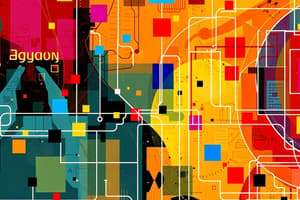Podcast
Questions and Answers
Which of the following factors is NOT mentioned as influencing Human Computer Interaction (HCI)?
Which of the following factors is NOT mentioned as influencing Human Computer Interaction (HCI)?
- Culture
- Other factors
- Ever-changing standards
- Technology advancement (correct)
Good technology is always defined by its usability alone.
Good technology is always defined by its usability alone.
False (B)
What does HCI study focus on concerning user performance?
What does HCI study focus on concerning user performance?
The interaction between humans and machines in the context of a system.
The Ergonomics Research Society, established in _____, focused on the physical characteristics of machines and systems.
The Ergonomics Research Society, established in _____, focused on the physical characteristics of machines and systems.
Which technology is known for its excellent video recording features, as mentioned for comparison?
Which technology is known for its excellent video recording features, as mentioned for comparison?
HCI is solely about improving technology without considering user experience.
HCI is solely about improving technology without considering user experience.
Name one example of a distinguishing factor between good and bad technology.
Name one example of a distinguishing factor between good and bad technology.
Match the technologies with their respective features:
Match the technologies with their respective features:
What is the primary goal of User Experience design?
What is the primary goal of User Experience design?
User Experience is only concerned with technology-related products.
User Experience is only concerned with technology-related products.
What does the term 'affordances' refer to in User Interface design?
What does the term 'affordances' refer to in User Interface design?
Usability in design primarily focuses on how easy or __________ it is to use a product.
Usability in design primarily focuses on how easy or __________ it is to use a product.
Match the types of user interfaces with their senses:
Match the types of user interfaces with their senses:
Which of the following questions is related to User Experience?
Which of the following questions is related to User Experience?
You push a car door handle to open it.
You push a car door handle to open it.
In which decade did the interest in User Experience gain momentum?
In which decade did the interest in User Experience gain momentum?
Which of the following is NOT one of the six design principles outlined by Donald Norman?
Which of the following is NOT one of the six design principles outlined by Donald Norman?
Usability testing only concerns measuring the user's satisfaction with a product.
Usability testing only concerns measuring the user's satisfaction with a product.
What term describes the restrictions to the kind of interactions possible with a device?
What term describes the restrictions to the kind of interactions possible with a device?
The principle that refers to the relationship between functional and spatial layout is called ______.
The principle that refers to the relationship between functional and spatial layout is called ______.
Match the types of usability constraints with their definitions:
Match the types of usability constraints with their definitions:
Which design principle focuses on how a product indicates its current status to the user?
Which design principle focuses on how a product indicates its current status to the user?
The principle of visibility deals with whether the user can see the controls of a device.
The principle of visibility deals with whether the user can see the controls of a device.
Why are constraints important in user-centered design?
Why are constraints important in user-centered design?
Which of the following is NOT a type of usability metric?
Which of the following is NOT a type of usability metric?
Mental models help users understand systems and predict their effects.
Mental models help users understand systems and predict their effects.
What is feedback in the context of usability?
What is feedback in the context of usability?
Design provides strong clues for __________.
Design provides strong clues for __________.
Match the following terms with their definitions:
Match the following terms with their definitions:
Why might designers be hesitant to try new ideas?
Why might designers be hesitant to try new ideas?
Business design is separate from technology design.
Business design is separate from technology design.
What is the primary purpose of usability metrics?
What is the primary purpose of usability metrics?
What is a possible outcome of a usability issue?
What is a possible outcome of a usability issue?
Efficiency is primarily concerned with the amount of effort required to complete a task.
Efficiency is primarily concerned with the amount of effort required to complete a task.
What is the maximum acceptable error rate determined by?
What is the maximum acceptable error rate determined by?
Errors that are assumed to be correct but are actually not are referred to as __________ errors.
Errors that are assumed to be correct but are actually not are referred to as __________ errors.
Which of the following factors indicates that an error has significant implications?
Which of the following factors indicates that an error has significant implications?
Match the types of errors with their descriptions:
Match the types of errors with their descriptions:
What design approach is used to tackle complicated problems in product development?
What design approach is used to tackle complicated problems in product development?
Multiple errors are assessed only by the number of times they occur.
Multiple errors are assessed only by the number of times they occur.
What does the ratio of success over time measure?
What does the ratio of success over time measure?
Gathering the user's preferences is an essential step in the 'Empathize' phase.
Gathering the user's preferences is an essential step in the 'Empathize' phase.
What should efficiency be defined by?
What should efficiency be defined by?
The key in the 'Empathize' phase is to ___ assume.
The key in the 'Empathize' phase is to ___ assume.
Match the terms with their definitions:
Match the terms with their definitions:
What is tracked to measure learnability?
What is tracked to measure learnability?
Task completion rate is irrelevant to measuring efficiency.
Task completion rate is irrelevant to measuring efficiency.
What is a trial in the context of learnability?
What is a trial in the context of learnability?
Flashcards
HCI
HCI
Human-Computer Interaction is a specialized field studying how humans interact with computers.
Good/Bad Technology
Good/Bad Technology
Technology quality depends on the user's needs and perspective.
HCI Components
HCI Components
HCI involves the computer, human, task, and usability.
HCI Research Goal
HCI Research Goal
Signup and view all the flashcards
Ergonomics Research
Ergonomics Research
Signup and view all the flashcards
User Experience (UX)
User Experience (UX)
Signup and view all the flashcards
User Interface (UI)
User Interface (UI)
Signup and view all the flashcards
HCI Challenges
HCI Challenges
Signup and view all the flashcards
Affordances
Affordances
Signup and view all the flashcards
UX Goal
UX Goal
Signup and view all the flashcards
UI senses
UI senses
Signup and view all the flashcards
Usability
Usability
Signup and view all the flashcards
Interaction Between People and Computers
Interaction Between People and Computers
Signup and view all the flashcards
Historical Context of UX
Historical Context of UX
Signup and view all the flashcards
Constraints
Constraints
Signup and view all the flashcards
Conceptual Models
Conceptual Models
Signup and view all the flashcards
Mappings
Mappings
Signup and view all the flashcards
Feedback
Feedback
Signup and view all the flashcards
Usability Testing
Usability Testing
Signup and view all the flashcards
Levels of Usability
Levels of Usability
Signup and view all the flashcards
Usability Metrics
Usability Metrics
Signup and view all the flashcards
Performance-based metrics
Performance-based metrics
Signup and view all the flashcards
Issues-based metrics
Issues-based metrics
Signup and view all the flashcards
Business system design
Business system design
Signup and view all the flashcards
Efficiency
Efficiency
Signup and view all the flashcards
Learnability
Learnability
Signup and view all the flashcards
Task Completion Rate
Task Completion Rate
Signup and view all the flashcards
Mean Time on Task
Mean Time on Task
Signup and view all the flashcards
Empathize
Empathize
Signup and view all the flashcards
Define
Define
Signup and view all the flashcards
Trial
Trial
Signup and view all the flashcards
Track Over Time
Track Over Time
Signup and view all the flashcards
Design Thinking
Design Thinking
Signup and view all the flashcards
Errors in Usability
Errors in Usability
Signup and view all the flashcards
Error Rate
Error Rate
Signup and view all the flashcards
Efficiency in Usability
Efficiency in Usability
Signup and view all the flashcards
Multiple Errors
Multiple Errors
Signup and view all the flashcards
Error Score
Error Score
Signup and view all the flashcards
Design Thinking Steps
Design Thinking Steps
Signup and view all the flashcards
User-Centric Approach
User-Centric Approach
Signup and view all the flashcards
Study Notes
Human Computer Interaction (HCI) Introduction
- Interest in building more effective weapons led to studying humans and machines.
- Ergonomics Research Society (1949) focused on the physical characteristics of machines and systems, and how they affected human performance.
- HCI includes the computer as the machine.
- HCI tries to answer questions about technology, and how to evaluate it.
- What makes a good and bad technology?
- How can good technology be built?
- How can good technology be validated?
- Good and bad technology depend on perspective. Some technologies are designed for a specific purpose.
- Examples include Nikon's ergonomic design, vs Canon's video recording features, and Apple's security vs Android's versatility.
Human Computer Interaction Components
- HCI is composed of computers, humans, and tasks.
- There is no unified theory due to culture, changing standards, and other factors.
User Experience vs. User Interface
- User Experience (UX) is the overall experience of using a product, like a website or app. How easy and enjoyable is it to use?
- User Experience encompasses all aspects of the user's interaction with a company, its services, and products.
- Example: Why are people addicted to Facebook? What makes them repeatedly do something?
- User Interface (UI) is the space where interactions between users and machines occur.
- Computers have three UI interfaces for different senses: vision, hearing, and touch. (monitors, projectors, screens, VRs; microphones, speakers, headsets; buttons, pens, touchscreens.)
Usability
- Usability is a major but abstract component of HCI. It involves the ease and use of objects that humans interact with.
- Usability is subjective and measured through testing.
- Techniques used include user-centered interaction design.
Design Principles (Donald Norman)
- Affordances: How to use something.
- Constraints: Why limitations exist.
- Conceptual models: Previous experience.
- Mappings: Where something is.
- Visibility: Can we see it?
- Feedback: What is the system doing?
Usability Metrics
- Different types include performance-based, issue-based, self-reported, and behavioral/psychological.
- Performance metrics determine the magnitude of a specific usability issue.
- How many people are likely to encounter a problem.
- Common examples include task success and time on task.
Design Thinking
- A non-linear process for tackling complex problems in product development.
- User-centric approach.
- Aims for practical and logical innovation.
- Steps include empathize, define, ideate, prototype, and test.
Module Summary
- HCI focuses on creating good design.
- It is composed of humans, computers, and tasks.
- UX is different from UI.
- Usability is an important component and can be measured through metrics.
Studying That Suits You
Use AI to generate personalized quizzes and flashcards to suit your learning preferences.




